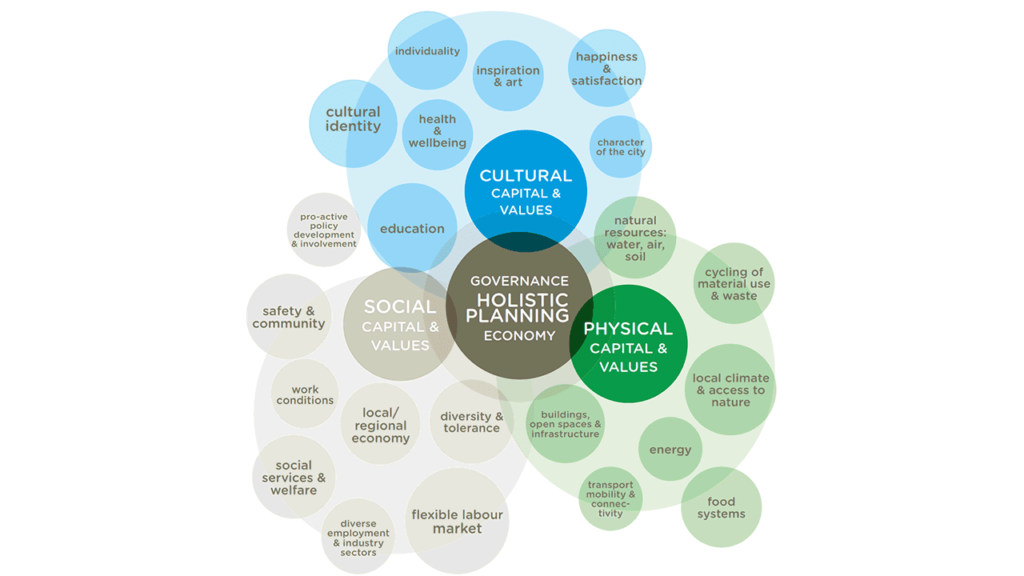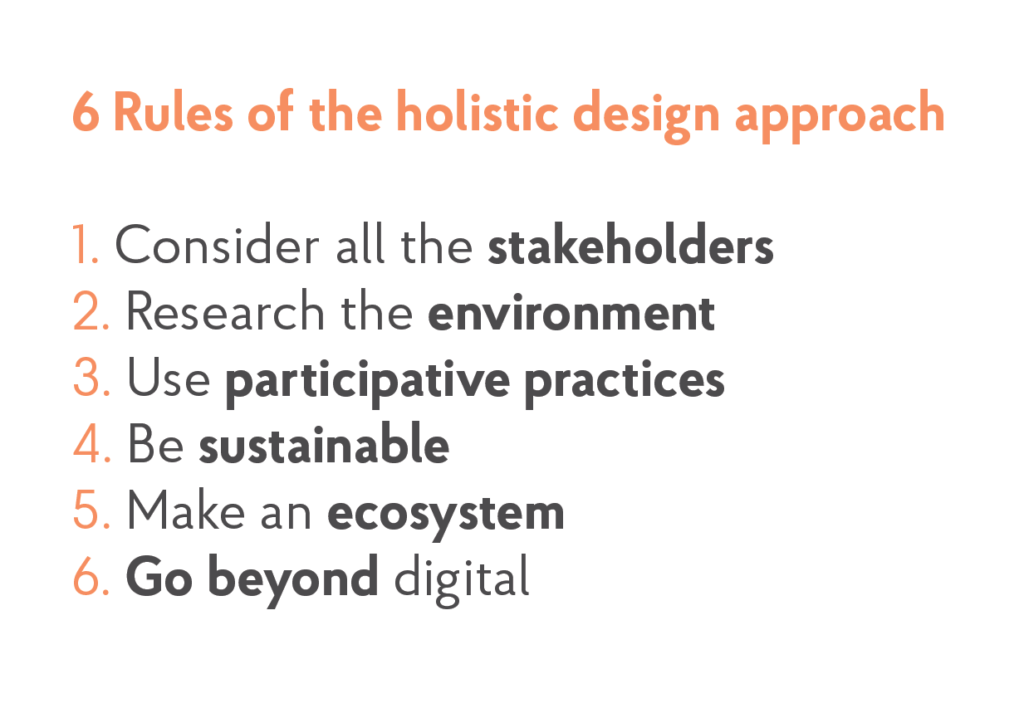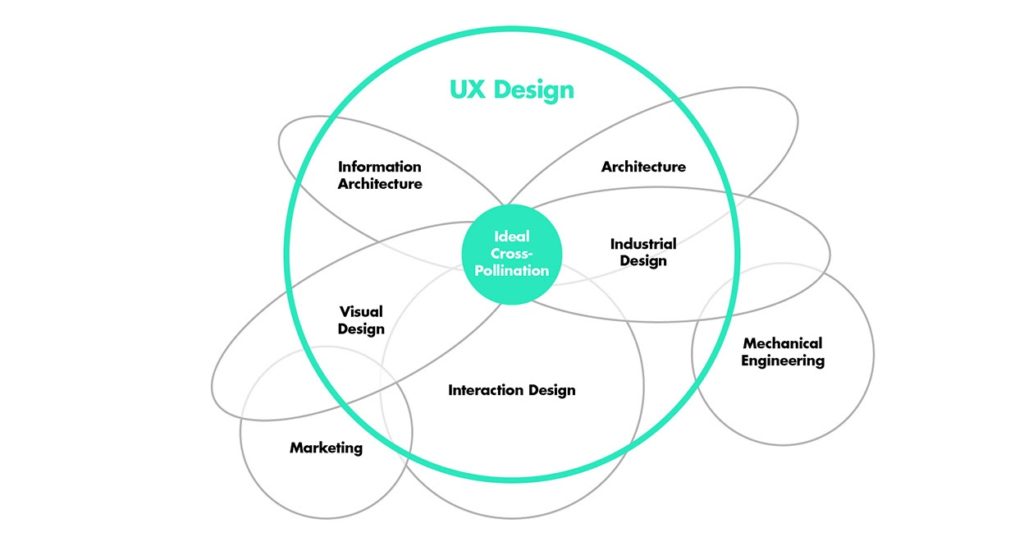We are an agency full of seasoned UX designers, but “holistic design” is not very easy to explain. Let’s start with the main question:
What is holistic design?
Holistic design is a design approach that suggests looking at the product from different angles, considering all the aspects, stakeholders, and the environment.
However, the definition of holistic design is not enough to really understand the phenomenon. The holistic design combines the approach, practices, and philosophy.
Holistic design is not something that happens solely in the design department. It is synchrony of all the company processes: to provide a holistic user experience, a good-looking UI is not enough, you need a holistic mindset.
The term “holistic design” is often used in architecture, urbanism, and interior design. For example, ancient Greek tractates about urban planning suggested that architects should consider the directions of the winds when projecting the streets of the city in order to create the most comfortable air circulation.

Some of the problems related to holistic design in other spheres can help better understand how holistic design can be applied in the modern digital world.
When projecting an interior, designers should not only think of the clients’ tastes and general style consistency. Here are some of the questions designers have to consider while developing a holistic design:
- Is the neighborhood noisy? Does the apartment need noise isolation?
- Are the materials sustainable? If we put this vintage fridge, would it be possible to fix it if it breaks in 5 years?
- Is the furniture resistant enough to the cat’s claws?
Holistic design is not something that every client wants. It is a long process and requires not only the budget but also time and will to change the corporate processes and even culture. Of course, the company aiming for holistic design should have a high level of UX maturity.
When the decision to adopt a holistic approach is well thought, you can start shifting to new design practices.
Rules of the holistic design approach

- Take into consideration all the stakeholders, not only users or customers. It doesn’t mean that we have to solve everyone’s problems with our product. Yet, we have to be aware of all things happening around us.
- Research methods. When we focus solely on users, individual interviews are a golden standard of UX research. When we decide to take a holistic approach, we have to add other methods to our research, such as ethnographic research. We have to go out in the field to better understand the environment.
- Participative practices. A step forward from taking into account all of the stakeholders is to involve them in the design process. It is likely to be tricky and even messy, but giving such approach a try doesn’t cost much. The promoter of design thinking, David Kelley, pointed out that involving people of different backgrounds significantly benefits the process.Sustainability. Most modern companies want to appear sustainable. They introduce the principle in various parts: from corporate responsibility programs to even the production process. There is always room for improvement in sustainability, and holistic design naturally raises the company standards.
- Ecosystem, not just design system. A design system is a great tool for the company, but it applies mostly to the design sphere. It is often used to simplify and unify UI/UX design. Holistic design implies an ecosystem including values, philosophy, and attention to every detail.
- Going beyond digital. Even if we are talking about a highly digitalized company, in the absolute majority of cases holistic design solutions will change physical items, such as offices, and also the human capital.
Real companies. Holistic or not?
As we say that holistic is an idealistic term, it is hard to say that any company at all is really holistic. Yet, there is some that move in that direction. Sometimes these are the same companies that invest in the petroleum industry (nobody said “holistic” was simple).
Let’s go through some examples to see how far famous companies can get on their way to becoming “holistic”. Is there a way to avoid mentioning Apple in an article about design? Not that we know.
Holistic style. Apple
Apple stands quite close to the holistic design approach. All the products have a clear consistent line, the company has a recognizable style and philosophy. All Apple products sync naturally and gather in an ecosystem: they look similar, they use the same software and user interface, they feel the same. Once people get used to the Apple ecosystem, they have hard times abandoning it.
However, the sustainability of Apple’s design is questionable. The company is constantly using the principle of planned obsolescence and its products are not very easy to repair. Also, the well-known method of Apple is to create users’ needs rather than satisfy existing ones. Products are often designed with limitations that require users to adapt to them rather than adapting to users: for example, new iPhones have no power adapters.
Design thinking applied. Bosch
The spectrum of the holistic design approach is large. It might be unexpectable to see this company as an example, but there is something we can learn from Bosch, a company with over 150 years history and quite a traditional line of products.
Apart from quality electro domestics, Bosch is known for its success in applying design thinking throughout a large established company. They started with launching a whole “design thinking department” and it changed the processes in the company leading to the redesign of office interiors to adapt to the reshaped collaboration models.
Bosch is now producing a wide range of products apart from washing machines. They construct smart buildings that promote sustainable living. This is a classic understanding of the holistic design approach in modern times.
One of the good practices that Bosch adopted is involving people of various profiles in the design process, such as engineers, testers, marketers, scientists. Diverse teams provide the best ground for innovative solutions.
How holistic is Bosch’s approach? They mostly declare the design thinking approach, but being an old German company working with product design, they are well familiar with the notion of holistic design from the first sources. How sustainable is their product? Well, we’ll leave it to the environmentalists.
Holistic path of small companies
In this article, we’ll leave apart the interior Feng Shui design companies and will focus on UX.
One of the companies that declare holistic design to be a cornerstone of their work is the Tactile design firm. They see UX as a cross-pollination of various disciplines, from architecture to marketing. No surprise that half of the company consists of industrial designers and engineers.

Designers at Tactile dedicate a lot of attention to studying the context of the product they are working on. Also, they surely go beyond digital as they work a lot on physical interfaces and innovative technologies.
As a UI/UX design agency, we are far from claiming ourselves holistically. However, we do like the approach and it is present in our work.
We always try to do a bit more than the client asks us. Solving the problem is good, but our objective is also to simplify the implementation of the design and think of design accessibility even when it is not in the brief.
Take a look at the case study of Handprinter, a lifestyle app. As the product itself is quite holistic, our approach was similar: we thought about all the stakeholders, thought not only about the principal user’s goal – decreasing the handprint – but also about other aspects, such as a social network of like-minded people.

What to start with?
If you are more than just curious about a holistic approach and want to try adopting it in your company, our advice is to start slow. Here are a few steps that will get you closer on the way to holistic design:
- Apply design thinking (you might think it is another buzz word and you’ve heard of it a thousand times already… But check out these design thinking examples from top companies if you have doubts).
- Design system. It’s likely that you already have one, but look at it closer: is it a real system based on philosophy or more of a visual components library? Are the principles of the design system used outside of design software?
- Check if your design is inclusive. Without being inclusive, there is no thinking of a holistic user experience.
- Provide consistent user experience. Make sure that your customers are enjoying interacting with the product at every moment of their journey. Every little thing is important for a holistic user experience. How to get there? Dig deeper into UX research, go beyond competitors’ analysis and user interviews.
To sum up
The most complicated thing about holistic design is that different people have very different images of it. The second most complicated thing is that the idea of holistic design is rather idealistic: each goal is never final, the path is ongoing. Yet, following this path would bring many pleasant bonuses on the way.
Let me finish with a quote from Karthik Vijayakumar, Founder, and Principal, DYT Studios & Host of The Design Your Thinking Podcast.
Holistic design is to see and think of the world in two broad dimensions – as interconnected and evolving systems. Holistic design is formed by and leads to interconnected systems. Evolving nature of holistic design is when the design leads to the evolution of interconnected systems.








